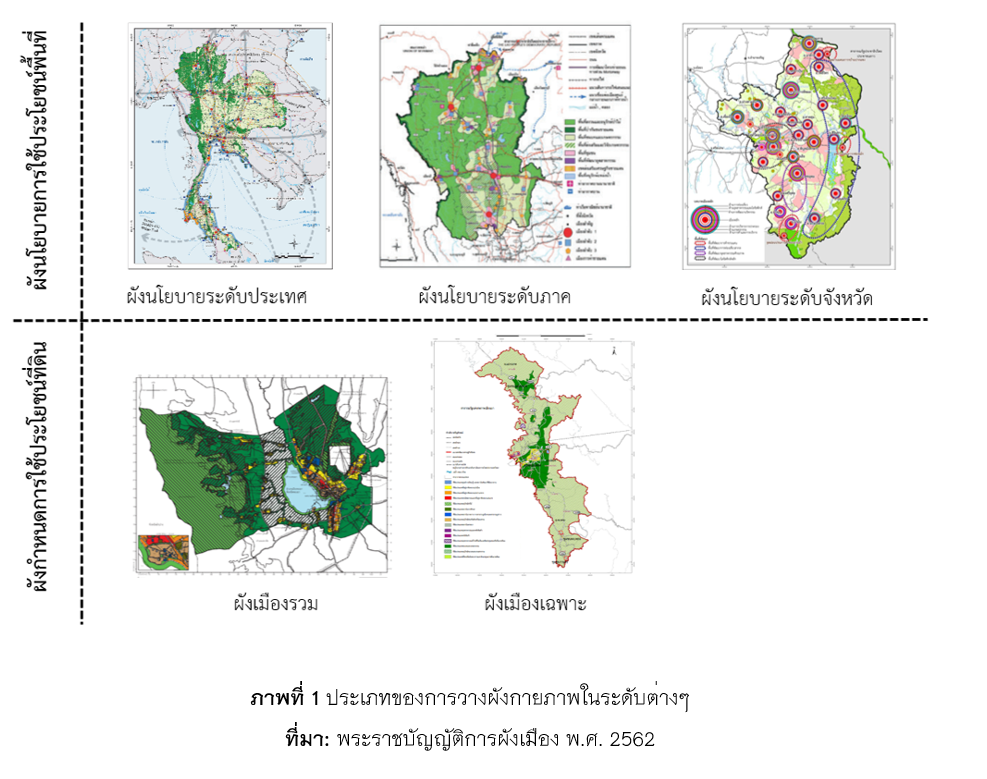Physical Planning and Its Public Participation in Thailand
Keywords:
Physical Planning, Public ParticipationAbstract
Physical planning or town planning is a serious attempt to determine the direction of development and control the areas to achieve the development goals. Physical planning is the implementation of policies or guidelines for economic, social, cultural, and environmental at the community, town, region, and country level. In terms of physical planning under the Town Planning Act B.E. 2562 (2019), Section 8, the town plans have been divided into 2 types: 1) area-use policy plans and 2) land use plans. The area-use policy plans are classified into three levels as follows: the national policy plan, regional policy plans, and province policy plans. Land use plans are classified into two types as follows: unitary town plans and specific town plans. In addition, public hearing, consultation and participation are required for formulation and preparation of the town plan. However, from past operations, it was found that the public participation has been low level because people still lack of knowledge and understanding in the process of the town plan. In order for people to involve in, it is necessary to create more knowledge, understanding and publicity of town plan information. Thus, effective and successful both area-use policy plans and land use plans shall desire cooperation, consultation, and participation from several agencies and organizations including the public sector, private sector, and local government organization in sharing information, seeking alternatives, and making the decision to contribute the benefit for all parties.
References
กรมโยธาธิการและผังเมือง. (2565). ประกาศคณะกรรมการผังเมือง เรื่อง หลักเกณฑ์และวิธีการรับฟังความคิดเห็น การปรึกษาหารือ และการมีส่วนร่วมของประชาชนในการวางและจัดทำผังเมืองรวม พ.ศ.2565. กรุงเทพฯ: กรมโยธาธิการและผังเมือง กระทรวงมหาดไทย.
กฤตพร ห้าวเจริญ. (2561). ทฤษฎีและแนวความคิดทางการวางแผนและผังเมือง. กรุงเทพฯ: ธรรมศาสตร์, สนพ. ม.
บุญศิริ สุขพร้อมสรรพ์. (2563). การวางผังเมืองในประเทศญี่ปุ่นสู่แนวปฏิบัติโดยชุมชน. วารสารวิชาการเพื่อการพัฒนานวัตกรรมเชิงพื้นที่, 1(3), 88-100.
พระราชบัญญัติการผังเมือง พ.ศ.2562. (2562, 29 พฤษภาคม). ราชกิจจานุเบกษา (เล่ม 136 ตอนที่ 71ก, น. 27-70).
ศรีสุดา วงษ์ชุ่ม. (2563). ผังเมืองกับการพัฒนาเมืองพะเยา. วารสารวิชาการเพื่อการพัฒนานวัตกรรมเชิงพื้นที่, 1(1), 83-91.
อัน นิมมานเหมินท์. (2527). การวางแผนกายภาพและการวางผังเมืองและชนบท [เอกสารประกอบโครงการฝึกอบรม เรื่อง การวางแผนและผังกายภาพสำหรับพนักงานท้องถิ่น]. กรุงเทพฯ: ภาควิชาการวางแผนภาคและเมือง คณะสถาปัตยกรรมศาสตร์ จุฬาลงกรณ์มหาวิทยาลัย.
American Planning Association. (2006). Planning and Urban Design Standards. New Jersey: John Wiley & Sons.
Arnstein, S. R. (1969). A ladder of citizen participation. Journal of the American Institute of planners, 35(4), 216-224.
Gupta, R.G. (1983). Planning and Development of Towns. New Delhi: Oxford and IHB Publishing.
Hack, G. (2000). Physical Planning and Urban Design. In A.J. Catanese and J.c. Snyder. (eds.), Urban Planning 2nd ed..
Ratcliffe, J. (1975). An Introduction to Town and County Planning. London: Hutchinson Education.
Sukpromsun, B., Koizumo, H., & Okata, J. (2010) Bangkok Comprehensive Plan and Their Participatory Actions. In Proceedings of the 8th Conference of Asian City Planning 2010, June 13th, 2010 (pp. 50-59). Japan: The Asian City Planning Group, City Planning Institute of Japan.





